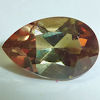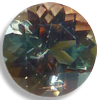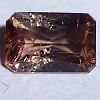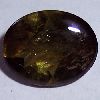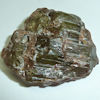
Often called “poor man’s Alexandrite” because its dichroism is similar to that of Alexandrite (red and green), but you can get it at a fraction of the cost. Its name is derived from the town in Spain where it was originally discovered. Some material still comes from Spain, but most Andalusite now comes from mines in Brazil and Sri Lanka.
For clarity, we should emphasize that dichroism is not the same as color change. Dichroism is not the same as color change. Dichroism is when you see different colors depending on the angle you view the gem. Color change is when you see different colors depending on the type of light source. Many gems are dichroic, but very few display distinctly different colors. Those that display distinctly different colors are unusual, but not nearly as rare as color change gems that display distinctly different colors.
The most common dichroism in Andalusite is the red/green. The red is more of a rust color and the green a deep forest green, but the clear distinction of the colors is what makes it unique. When faceted, the pavilion facet angles reflect both colors in the table. In cabochon, the color is determined mostly by the orientation the cutter chooses; due to the crystal structure of the gem, the green is most common. In its rough form the dichroism is obvious and very interesting to view. Look down the length of the crystal and only the rusty red color shows; view it sideways and only the green color shows.
Andalusite has perfect cleavage in two planes, so the crystals tend to break easily in to long thin blocks. This makes it very difficult to cut and large pieces extremely rare. That is why stones less than 1 carat are generally inexpensive, but stones above 1 ct increase rapidly in price. The most sought after pieces are ones that display equally the two colors. However, even gems that are dominant in one color are still quite desirable as long as some dichroic component is visible. Like Emerald, inclusions in Andalusite are quite common so it is extremely rare to have clean gems. Lightly included gems are often considered top grade.
Remember, this is a gem for collectors or for the artist that has a piece that can really benefit from the uniqueness of the dichroism. Its hardness is moderate, but its perfect cleavage makes it imperative that it be set in a protected setting. It is not treated in any manner and the colors are stable so no special treatment is required. It is perfect for unique earrings. It is also great for accent stones to help pull the red/green colors in your jewelry (consider Fire Agate, Opal, rainbow Obsidian, Labradorite, etc).
